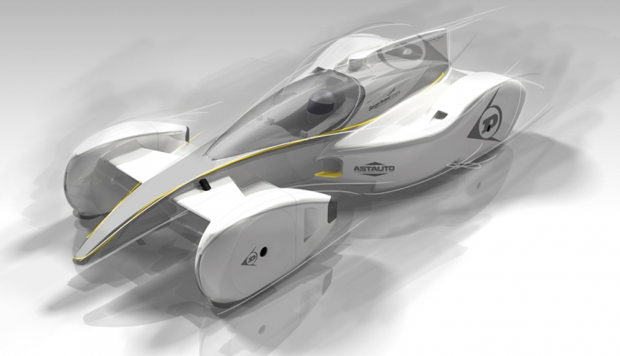Culminating this innovative design campaign, Dunlop enlisted the help of renowned race car designer Sergio Rinland, who reviewed the ideas submitted by fans across Europe on powertrains, aerodynamics, brakes and tyres, and combined them into an innovative sketch.
Electric powertrain, camera navigation, morphing shape with no wings needed for down force, intelligent tyres, ERS replacing disc brakes, are just some of the elements of the ‘race car of the future’, designed by Sergio Rinland. The vehicle has been designed with four electric motors that would initially sit in-board the vehicle. As technology progresses and motors become lighter and more powerful, they will become out-board, in wheel motors, providing even more flexibility on the track.
With one individual motor per wheel, the car has the capability of torque vectoring between each tyre. Administering the torque at each wheel will improve the aerodynamics efficiency and the use of tyres, as it will no longer be necessary for the wheels to turn when approaching a corner.
Initially this design has a Hydrogen fuel-cell electricity generator on-board, with a small Li-Ion battery as a power buffer. As the technology develops, this design has the possibility to incorporate induction charging pads on-board. Closed racing circuits may have induction charging infrastructure in the future, allowing the cars to run without having to carry the energy on-board, which will make this vehicle even more efficient and lighter.
The car has been designed with piezoelectric materials in its composite materials laminate. The adaptive bodywork will allow the car to change its shape to reduce drag on the straights, increase down force in the corners and control all cooling needs as the car runs. In addition, by incorporating nanoparticles into these composite materials, the structure of the car will have further enhanced strength, lightness and safety features.
Cameras and small screens (which will be inside the canopy) will give the driver 360° peripheral vision, rather than vision through traditional car mirrors, enhancing safety alongside reducing drag.
Using technology that Dunlop is currently developing, tyres will have internal sensors to send information to the control systems; these will be able to adapt the suspension, power delivery and braking systems to utilise the tyres to maximum advantage.
By embedding intelligent materials such as the ones used in the bodywork, the tyres will be able to control their temperature and pressure, as well as change shape. This will allow reduced rolling resistance and induced drag in the straights (e.g. taking the shape of a motorbike tyre), and increased contact patch area during the braking and cornering events.
Also, by having tyres that adapt themselves to the circumstances and the environment, it will not be necessary to change them for weather conditions nor for wear – they will last for the whole race.
No energy-wasteful brakes will be used; all the braking energy will be recovered and stored in flywheels and/or super-capacitors to be used for power peaks events during the races.
Electronics and control systems will be advanced to such an extent that the driver will evolve to be more of a ‘vehicle operator’. This is a similar evolution than we have seen in the last 30 years, not to say 125 years!


